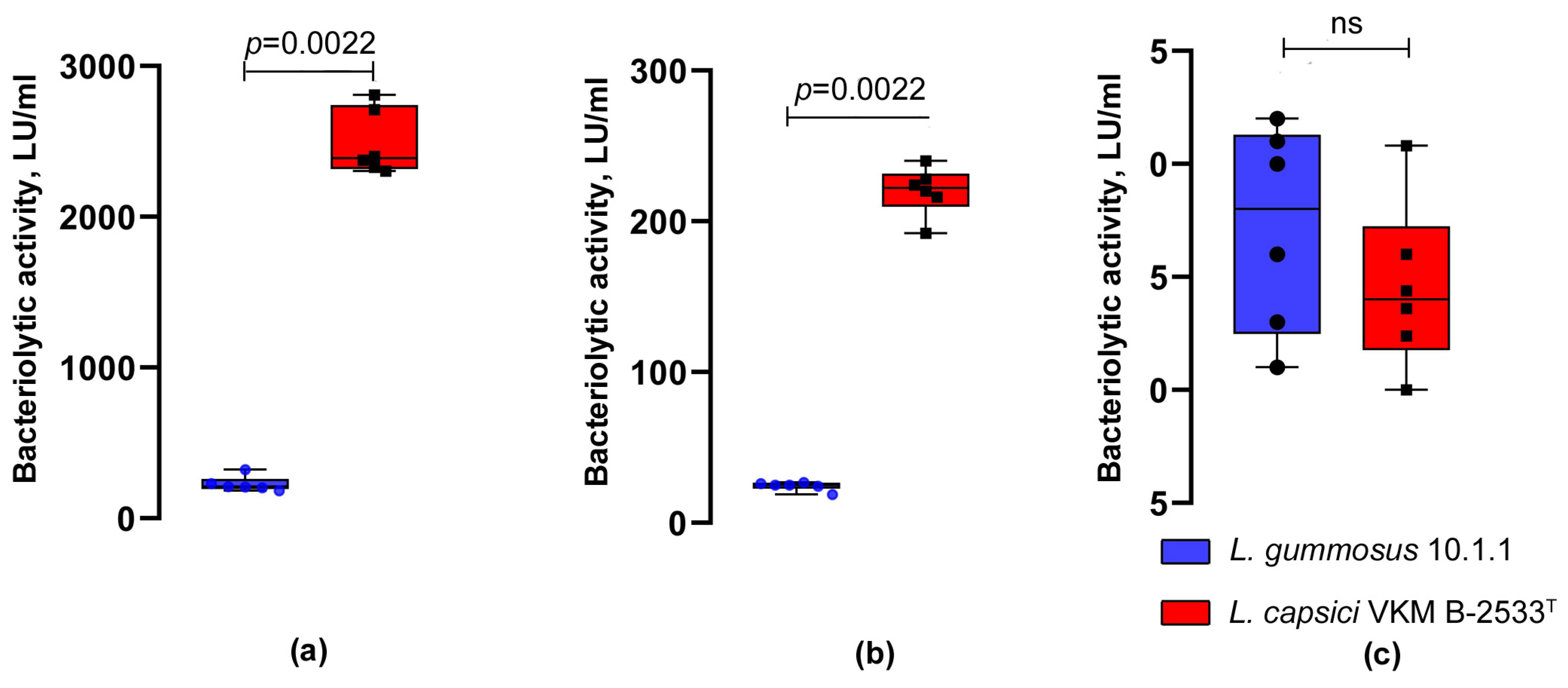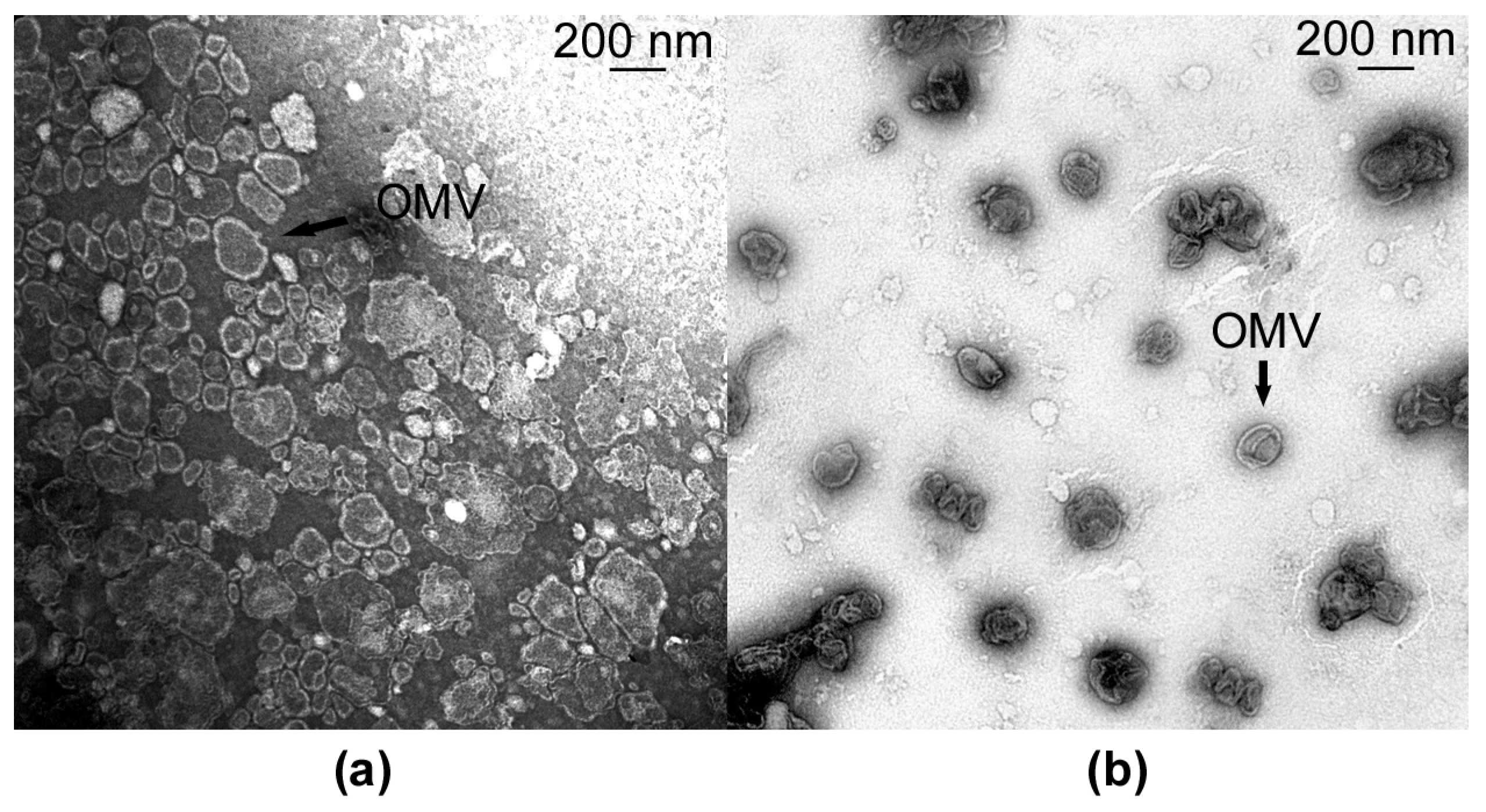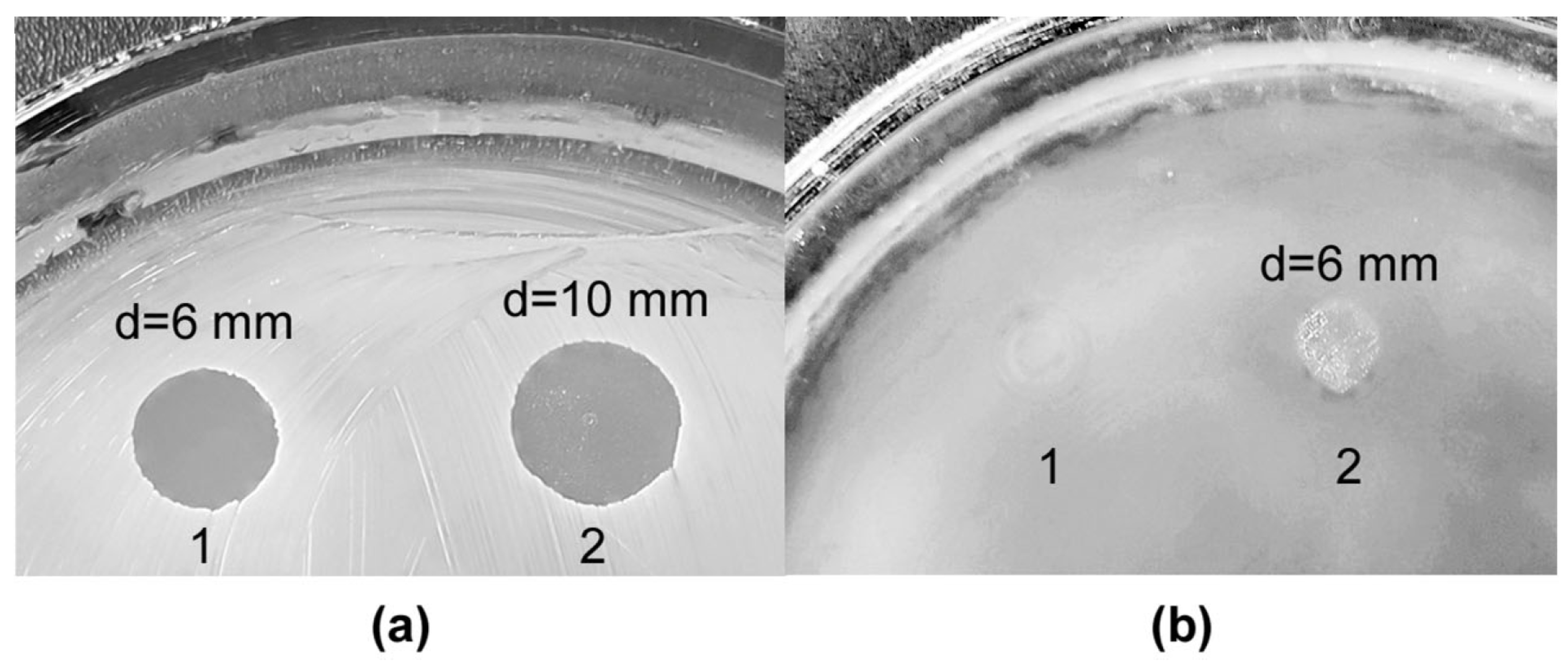Lysobacter gummosus 10.1.1, a Producer of Antimicrobial Agents
Abstract
:1. Introduction
2. Materials and Methods
2.1. Cultivation Conditions
2.2. Turbidimetric Determination of Bacteriolytic Activity
2.3. Determination of Lytic Activity via Spot Test
2.4. Isolation of Outer Membrane Vesicles
2.5. Protein Concentration Assay
2.6. Transmission Electron Microscopy
2.7. SDS-PAGE under Denaturing Conditions
2.8. Isolation of RNA
2.9. RNA-Seq Data Analysis
2.10. Statistical Analysis
3. Results
3.1. Characterization of Strain L. gummosus 10.1.1
3.2. Assessment of L. gummosus 10.1.1 Antimicrobial Potential via Transcriptomic Analysis
3.2.1. Search for the Genes of L. gummosus 10.1.1 Bacteriolytic Enzymes
3.2.2. Search for Genes of L. gummosus 10.1.1 Antifungal Enzymes
3.2.3. Search for Genes Responsible for Biosynthesis of Antibiotics in L. gummosus 10.1.1
4. Discussion
Supplementary Materials
Author Contributions
Funding
Data Availability Statement
Acknowledgments
Conflicts of Interest
References
- Christensen, P.; Cook, F.D. Lysobacter, a New Genus of Nonfruiting, Gliding Bacteria with a High Base Ratio. Int. J. Syst. Evol. Microbiol. 1978, 28, 367–393. [Google Scholar] [CrossRef]
- Xie, Y.; Wright, S.; Shen, Y.; Du, L. Bioactive Natural Products from Lysobacter. Nat. Prod. Rep. 2012, 29, 1277–1287. [Google Scholar] [CrossRef]
- Panthee, S.; Hamamoto, H.; Paudel, A.; Sekimizu, K. Lysobacter species: A Potential Source of Novel Antibiotics. Arch. Microbiol. 2016, 198, 839–845. [Google Scholar] [CrossRef] [PubMed]
- Kudryakova, I.V.; Shishkova, N.A.; Vasilyeva, N.V. Outer Membrane Vesicles of Lysobacter sp. XL1: Biogenesis, Functions, and Applied Prospects. Appl. Microbiol. Biotechnol. 2016, 100, 4791–4801. [Google Scholar] [CrossRef] [PubMed]
- Puopolo, G.; Tomada, S.; Pertot, I. The Impact of the Omics Era on the Knowledge and Use of Lysobacter species to Control Phytopathogenic Micro-Organisms. J. Appl. Microbiol. 2017, 124, 15–27. [Google Scholar] [CrossRef] [PubMed]
- Afoshin, A.S.; Kudryakova, I.V.; Borovikova, A.O.; Suzina, N.E.; Toropygin, I.Y.; Shishkova, N.A.; Vasilyeva, N.V. Lytic Potential of Lysobacter capsici VKM B-2533T: Bacteriolytic Enzymes and Outer Membrane Vesicles. Sci. Rep. 2020, 10, 9944. [Google Scholar] [CrossRef]
- Afoshin, A.; Kudryakova, I.; Tarlachkov, S.; Leontyevskaya, E.; Zelenov, D.; Rudenko, P.; Leontyevskaya Vasilyeva, N. Transcriptomic Analysis Followed by the Isolation of Extracellular Bacteriolytic Proteases from Lysobacter capsici VKM B-2533T. Int. J. Mol. Sci. 2023, 24, 11652. [Google Scholar] [CrossRef]
- Zhang, W.; Li, Y.; Qian, G.; Wang, Y.; Chen, H.; Li, Y.-Z.; Liu, F.; Shen, Y.; Du, L. Identification and Characterization of the Anti-Methicillin-Resistant Staphylococcus aureus WAP-8294A2 Biosynthetic Gene Cluster from Lysobacter enzymogenes OH11. Antimicrob. Agents Chemother. 2011, 55, 5581–5589. [Google Scholar] [CrossRef]
- Brescia, F.; Vlassi, A.; Bejarano, A.; Seidl, B.; Marchetti-Deschmann, M.; Schuhmacher, R.; Puopolo, G. Characterisation of the Antibiotic Profile of Lysobacter capsici AZ78, an Effective Biological Control Agent of Plant Pathogenic Microorganisms. Microorganisms 2021, 9, 1320. [Google Scholar] [CrossRef]
- Cimmino, A.; Bejarano, A.; Masi, M.; Puopolo, G.; Evidente, A. Isolation of 2,5-Diketopiperazines from Lysobacter capsici AZ78 with Activity against Rhodococcus fascians. Nat. Prod. Res. 2021, 35, 4969–4977. [Google Scholar] [CrossRef]
- Lin, L.; Xu, K.; Shen, D.; Chou, S.H.; Gomelsky, M.; Qian, G. Antifungal Weapons of Lysobacter, a Mighty Biocontrol Agent. Environ. Microbiol. 2021, 23, 5704–5715. [Google Scholar] [CrossRef] [PubMed]
- Kudryakova, I.V.; Afoshin, A.S.; Ivashina, T.V.; Suzina, N.E.; Leontyevskaya, E.A.; Leontyevskaya (Vasilyeva), N.V. Deletion of alpB Gene Influences Outer Membrane Vesicles Biogenesis of Lysobacter sp. XL1. Front. Microbiol. 2021, 12, 715802. [Google Scholar] [CrossRef] [PubMed]
- Meers, P.R.; Liu, C.; Chen, R.; Bartos, W.; Davis, J.; Dziedzic, N.; Orciuolo, J.; Kutyla, S.; Pozo, M.J.; Mithrananda, D.; et al. Vesicular Delivery of the Antifungal Antibiotics of Lysobacter enzymogenes C3. Appl. Environ. Microbiol. 2018, 84, e01353-18. [Google Scholar] [CrossRef]
- Whitaker, D.R. Lytic Enzymes of Sorangium Sp. Isolation and Enzymatic Properties of the Alpha- and Beta-Lytic Proteases. Can. J. Biochem. 1965, 43, 1935–1954. [Google Scholar] [CrossRef] [PubMed]
- Li, S.; Norioka, S.; Sakiyama, F. Purification, Characterization, and Primary Structure of a Novel Cell Wall Hydrolytic Amidase, CwhA, from Achromobacter lyticus. J. Biochem. 2000, 127, 1033–1039. [Google Scholar] [CrossRef] [PubMed]
- Stepnaya, O.A.; Ledova, L.A.; Kulaev, I.S. Bacteriolytic Enzymes. Usp. Biol. Khim 1999, 39, 327–354. [Google Scholar]
- Vasilyeva, N.V.; Shishkova, N.A.; Marinin, L.I.; Ledova, L.A.; Tsfasman, I.M.; Muranova, T.A.; Stepnaya, O.A.; Kulaev, I.S. Lytic Peptidase L5 of Lysobacter sp. XL1 with Broad Antimicrobial Spectrum. J. Mol. Microbiol. Biotechnol. 2014, 24, 59–66. [Google Scholar] [CrossRef]
- Gökçen, A.; Vilcinskas, A.; Wiesner, J. Biofilm-Degrading Enzymes from Lysobacter gummosus. Virulence 2014, 5, 378–387. [Google Scholar] [CrossRef]
- Gómez Expósito, R.; Postma, J.; Raaijmakers, J.M.; De Bruijn, I. Diversity and Activity of Lysobacter species from Disease Suppressive Soils. Front. Microbiol. 2015, 6, 1243. [Google Scholar] [CrossRef]
- Postma, J.; Schilder, M.T.; Bloem, J.; van Leeuwen-Haagsma, W.K. Soil Suppressiveness and Functional Diversity of the Soil Microflora in Organic Farming Systems. Soil Biol. Biochem. 2008, 40, 2394–2406. [Google Scholar] [CrossRef]
- Tarlachkov, S.V.; Kudryakova, I.V.; Afoshin, A.S.; Leontyevskaya, E.A.; Leontyevskaya Vasilyeva, N.V. Whole-Genome Sequencing of Lysobacter capsici VKM B-2533T and Lysobacter gummosus 10.1.1, Promising Producers of Lytic Agents. Microbiol. Resour. Announc. 2022, 11, e0048422. [Google Scholar] [CrossRef] [PubMed]
- Kulaev, I.S.; Stepnaya, O.A.; Tsfasman, I.M.; Tchermenskaja, T.S.; Ledova, L.A.; Zubrizkaja, L.G.; Akimenko, V.K. Bacteriolytic Complex, Method for Producing Said Complex and Strain for Carrying out Said Method. RF Patent No. 2,193,063, 20 November 2002. (In Russian). [Google Scholar]
- Laemmli, U.K. Cleavage of Structural Proteins during the Assembly of the Head of Bacteriophage T4. Nature 1970, 227, 680–685. [Google Scholar] [CrossRef]
- Fernandez-Patron, C.; Castellanos-Serra, L.; Rodriguez, P. Reverse Staining of Sodium Dodecyl Sulfate Polyacrylamide Gels by Imidazole-Zinc Salts: Sensitive Detection of Unmodified Proteins. Biotechniques 1992, 12, 564–573. [Google Scholar] [PubMed]
- Andrews, S. FastQC: A Quality Control Tool for High Throughput Sequence Data. Available online: http://www.bioinformatics.babraham.ac.uk/projects/fastqc (accessed on 20 June 2023).
- Bolger, A.M.; Lohse, M.; Usadel, B. Trimmomatic: A Flexible Trimmer for Illumina Sequence Data. Bioinformatics 2014, 30, 2114–2120. [Google Scholar] [CrossRef] [PubMed]
- Langmead, B.; Salzberg, S.L. Fast Gapped-Read Alignment with Bowtie 2. Nat. Methods 2012, 9, 357–359. [Google Scholar] [CrossRef]
- Liao, Y.; Smyth, G.K.; Shi, W. featureCounts: An Efficient General Purpose Program for Assigning Sequence Reads to Genomic Features. Bioinformatics 2014, 30, 923–930. [Google Scholar] [CrossRef]
- Love, M.I.; Huber, W.; Anders, S. Moderated Estimation of Fold Change and Dispersion for RNA-Seq Data with DESeq2. Genome Biol. 2014, 15, 550. [Google Scholar] [CrossRef]
- Criscuolo, A. On the Transformation of MinHash-Based Uncorrected Distances into Proper Evolutionary Distances for Phylogenetic Inference. F1000Research 2020, 9, 1309. [Google Scholar] [CrossRef]
- Blin, K.; Shaw, S.; Kloosterman, A.M.; Charlop-Powers, Z.; van Wezel, G.P.; Medema, M.H.; Weber, T. antiSMASH 6.0: Improving Cluster Detection and Comparison Capabilities. Nucleic Acids Res. 2021, 49, W29–W35. [Google Scholar] [CrossRef]
- Stepnaia, O.A.; Begunova, E.A.; Tsfasman, I.M.; Kulaev, I.S. Bacteriolytic Enzyme Preparation Lysoamidase. Purification and Some Properties of Bacteriolytic Peptidase L1. Biokhimiia 1996, 61, 656–663. [Google Scholar]
- Palumbo, J.D.; Yuen, G.Y.; Jochum, C.C.; Tatum, K.; Kobayashi, D.Y. Mutagenesis of Beta-1,3-Glucanase Genes in Lysobacter enzymogenes Strain C3 Results in Reduced Biological Control Activity Toward Bipolaris Leaf Spot of Tall Fescue and Pythium Damping-Off of Sugar Beet. Phytopathology 2005, 95, 701–707. [Google Scholar] [CrossRef]
- Yano, S.; Kanno, H.; Tsuhako, H.; Ogasawara, S.; Suyotha, W.; Konno, H.; Makabe, K.; Uechi, K.; Taira, T. Cloning, Expression, and Characterization of a GH 19-Type Chitinase with Antifungal Activity from Lysobacter sp. MK9-1. J. Biosci. Bioeng. 2021, 131, 348–355. [Google Scholar] [CrossRef]
- Wang, P.; Chen, H.; Qian, G.; Liu, F. LetR Is a TetR Family Transcription Factor from Lysobacter Controlling Antifungal Antibiotic Biosynthesis. Appl. Microbiol. Biotechnol. 2017, 101, 3273–3282. [Google Scholar] [CrossRef]
- Su, Z.; Han, S.; Fu, Z.Q.; Qian, G.; Liu, F. Heat-Stable Antifungal Factor (HSAF) Biosynthesis in Lysobacter enzymogenes Is Controlled by the Interplay of Two Transcription Factors and a Diffusible Molecule. Appl. Environ. Microbiol. 2018, 84, e01754-17. [Google Scholar] [CrossRef]
- Xu, G.; Han, S.; Huo, C.; Chin, K.-H.; Chou, S.-H.; Gomelsky, M.; Qian, G.; Liu, F. Signaling Specificity in the C-Di-GMP-Dependent Network Regulating Antibiotic Synthesis in Lysobacter. Nucleic Acids Res. 2018, 46, 9276–9288. [Google Scholar] [CrossRef]
- Ren, X.; Ren, S.; Xu, G.; Dou, W.; Chou, S.-H.; Chen, Y.; Qian, G. Knockout of Diguanylate Cyclase Genes in Lysobacter enzymogenes to Improve Production of Antifungal Factor and Increase Its Application in Seed Coating. Curr. Microbiol. 2020, 77, 1006–1015. [Google Scholar] [CrossRef]
- de Bruijn, I.; Cheng, X.; de Jager, V.; Expósito, R.G.; Watrous, J.; Patel, N.; Postma, J.; Dorrestein, P.C.; Kobayashi, D.; Raaijmakers, J.M. Comparative Genomics and Metabolic Profiling of the Genus Lysobacter. BMC Genom. 2015, 16, 991. [Google Scholar] [CrossRef]
- Zhang, X.J.; Yao, Q.; Wang, Y.H.; Yang, S.Z.; Feng, G.D.; Zhu, H.H. Lysobacter silvisoli sp. Nov., Isolated from Forest Soil. Int. J. Syst. Evol. Microbiol. 2019, 69, 93–98. [Google Scholar] [CrossRef]
- Toyofuku, M.; Nomura, N.; Eberl, L. Types and Origins of Bacterial Membrane Vesicles. Nat. Rev. Microbiol. 2019, 17, 13–24. [Google Scholar] [CrossRef]
- Furuyama, N.; Sircili, M.P. Outer Membrane Vesicles (OMVs) Produced by Gram-Negative Bacteria: Structure, Functions, Biogenesis, and Vaccine Application. Biomed. Res. Int. 2021, 2021, 1490732. [Google Scholar] [CrossRef]
- Rawlings, N.D.; Barrett, A.J.; Thomas, P.D.; Huang, X.; Bateman, A.; Finn, R.D. The MEROPS Database of Proteolytic Enzymes, Their Substrates and Inhibitors in 2017 and a Comparison with Peptidases in the PANTHER Database. Nucleic Acids Res. 2018, 46, D624–D632. [Google Scholar] [CrossRef] [PubMed]
- Kessler, E.; Ohman, D.E. Chapter 349—Staphylolysin. In Handbook of Proteolytic Enzymes (Third Edition); Rawlings, N.D., Salvesen, G., Eds.; Academic Press; Elsevier: London, UK, 2013; pp. 1553–1558. ISBN 978-0-12-382219-2. [Google Scholar]
- Li, S.; Jochum, C.C.; Yu, F.; Zaleta-Rivera, K.; Du, L.; Harris, S.D.; Yuen, G.Y. An Antibiotic Complex from Lysobacter enzymogenes strain C3: Antimicrobial Activity and Role in Plant Disease Control. Phytopathology 2008, 98, 695–701. [Google Scholar] [CrossRef] [PubMed]
- van Staden, A.D.P.; van Zyl, W.F.; Trindade, M.; Dicks, L.M.T.; Smith, C. Therapeutic Application of Lantibiotics and Other Lanthipeptides: Old and New Findings. Appl. Environ. Microbiol. 2021, 87, e00186-21. [Google Scholar] [CrossRef]
- O’Sullivan, J.; McCullough, J.E.; Tymiak, A.A.; Kirsch, D.R.; Trejo, W.H.; Principe, P.A. Lysobactin, a Novel Antibacterial Agent Produced by Lysobacter sp. I. Taxonomy, Isolation and Partial Characterization. J. Antibiot. 1988, 41, 1740–1744. [Google Scholar] [CrossRef]
- Burkhart, B.J.; Schwalen, C.J.; Mann, G.; Naismith, J.H.; Mitchell, D.A. YcaO-Dependent Posttranslational Amide Activation: Biosynthesis, Structure, and Function. Chem. Rev. 2017, 117, 5389–5456. [Google Scholar] [CrossRef]





| Test Objects | Culture Fluid of L. gummosus 10.1.1, LU/mL | Culture Fluid of L. capsici VKM B-2533T, LU/mL |
|---|---|---|
| Bacteria * | ||
| M. luteus Ac-2230T | 227 ± 50 | 2488 ± 216 |
| S. aureus 209P | 24 ± 3 | 220 ± 16 |
| B. cereus 217 | 27 ± 4 | 25 ± 4 |
| K. rosea Ac-2200T | 0 | 42 ± 5 |
| P. aeruginosa | 0 | 0 |
| P. vulgaris H-19 | 0 | 0 |
| Mycelial fungi ** | ||
| F. solani | – | ++ |
| S. sclerotiorum | – | ++ |
| Test Objects | OMVs of L. gummosus 10.1.1, d * (mm) | OMVs of L. capsici VKM B-2533T, d (mm) |
|---|---|---|
| Bacteria | ||
| M. luteus Ac-2230T | 10 | 9 |
| S. aureus 209P | 10 | 6 |
| B. cereus 217 | 6 | 7 |
| K. rosea Ac-2200T | 11 | 10 |
| P. aeruginosa | 6 | – |
| P. vulgaris H-19 | – | – |
| Mycelial fungi | ||
| F. solani | – | 5 |
| S. sclerotiorum | – | 2.5 |
| Enzymes | Change of Expression * |
|---|---|
| (protein_id)/(locus_tag) | |
| The known bacteriolytic enzymes of Lysobacter | |
| Protease Blp | 3.7 |
| (UNP30460.1)/(MOV92_04075) | |
| Protease L1 | 8.6 |
| (UNP31219.1)/(MOV92_08245) | |
| Protease L4 | ns |
| (UNP27667.1)/(MOV92_14190) | |
| Protease L5 | No ortholog |
| Protease Serp | ns |
| (UNP30471.1)/(MOV92_04130) | |
| Protease Serp6 | 5.1 |
| (UNP29484.1)/(MOV92_23985) | |
| Protease Serp7 | 2.7 |
| (UNP31934.1)/(MOV92_12050) | |
| N-Acetylglucosaminidase | 0.6 |
| (UNP30329.1)/(MOV92_03340) | |
| Protease Serp3 | 5.8 |
| (UNP31461.1)/(MOV92_09555) | |
| Enzymes with putative bacteriolytic activities | |
| N-Acetylmuramoyl-L-alanine amidase | 2.0 |
| (UNP30261.1)/(MOV92_02985) | |
| Serine protease S8 | 1.4 |
| (UNP29437.1)/(MOV92_23735) | |
| Serine protease S8 | 3.8 |
| (UNP29878.1)/(MOV92_00900) | |
| M4 family metallopeptidase | 7.0 |
| (UNP27383.1)/(MOV92_12645) | |
| M4 family metallopeptidase | 2.9 |
| (UNP29729.1)/(MOV92_00120) | |
| M23 family metallopeptidase | 2.2 |
| (UNP30682.1)/(MOV92_05310) | |
| M4 family metallopeptidase | 2.0 |
| (UNP30981.1)/(MOV92_06955) | |
| PKD domain-containing protein S1D | 2.5 |
| (UNP28310.1)/(MOV92_17670) | |
| Antifungal enzymes | |
| β-1,3-Glucanase GluA | 199.5 |
| (UNP31829.1)/(MOV92_11495) | |
| β-1,3-Glucanase GluB | 347.7 |
| (UNP30940.1)/(MOV92_06720) | |
| β-1,3-Glucanase GluC | 5.3 |
| (UNP31788.1)/(MOV92_11290) | |
| Chitinase | 5.4 |
| (UNP31513.1)/(MOV92_09815) | |
| Proteins | Change of Expression * |
|---|---|
| (protein_id)/(locus_tag) | |
| Class III lanthipeptide | No ortholog |
| Class III lanthionine synthetase LanKC | No ortholog |
| Class 2 lanthipeptide synthetase LanM family protein | 2.4 |
| (UNP31401.1)/(MOV92_09240) | |
| Non-ribosomal peptide synthetase | 22.2 |
| (UNP29365.1)/(MOV92_23340) | |
| HSAF biosynthetic non-ribosomal peptide synthetase/polyketide synthase | 116.3 |
| (UNP27785.1)/(MOV92_14840) | |
| Non-ribosomal peptide synthetase (lysobactin) | 2.0 |
| (UNP31811.1)/(MOV92_11405) | |
| 3.4 | |
| (UNP31812.1)/(MOV92_11410) | |
| YcaO-like family protein | 2.5 |
| (UNP28784.1)/(MOV92_20230) | |
| Class 2 lanthipeptide synthetase LanM | 1.9 |
| (UNP29075.1)/(MOV92_21820) | |
| 1.3 | |
| (UNP29632.1)/(MOV92_24800) |
Disclaimer/Publisher’s Note: The statements, opinions and data contained in all publications are solely those of the individual author(s) and contributor(s) and not of MDPI and/or the editor(s). MDPI and/or the editor(s) disclaim responsibility for any injury to people or property resulting from any ideas, methods, instructions or products referred to in the content. |
© 2023 by the authors. Licensee MDPI, Basel, Switzerland. This article is an open access article distributed under the terms and conditions of the Creative Commons Attribution (CC BY) license (https://creativecommons.org/licenses/by/4.0/).
Share and Cite
Kudryakova, I.; Afoshin, A.; Tarlachkov, S.; Leontyevskaya, E.; Suzina, N.; Leontyevskaya, N. Lysobacter gummosus 10.1.1, a Producer of Antimicrobial Agents. Microorganisms 2023, 11, 2853. https://doi.org/10.3390/microorganisms11122853
Kudryakova I, Afoshin A, Tarlachkov S, Leontyevskaya E, Suzina N, Leontyevskaya N. Lysobacter gummosus 10.1.1, a Producer of Antimicrobial Agents. Microorganisms. 2023; 11(12):2853. https://doi.org/10.3390/microorganisms11122853
Chicago/Turabian StyleKudryakova, Irina, Alexey Afoshin, Sergey Tarlachkov, Elena Leontyevskaya, Natalia Suzina, and Natalia Leontyevskaya (Vasilyeva). 2023. "Lysobacter gummosus 10.1.1, a Producer of Antimicrobial Agents" Microorganisms 11, no. 12: 2853. https://doi.org/10.3390/microorganisms11122853





